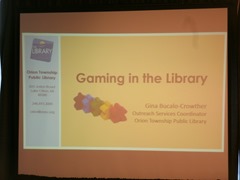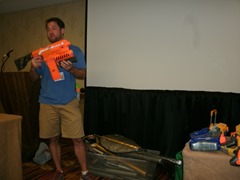 Although Gen Con technically doesn’t commence until tomorrow, today Gen Con held a special industry-and-educators-only event called Gen Con Trade Day. Since I am attending the convention on a press pass, I was also eligible to attend.
Although Gen Con technically doesn’t commence until tomorrow, today Gen Con held a special industry-and-educators-only event called Gen Con Trade Day. Since I am attending the convention on a press pass, I was also eligible to attend.
There were panels available to librarians, educators, and game retail store employees, focusing on game-related issues of interest to these parties. Given the focus of this blog, I largely chose library tracks with a couple of education tracks. The panels were all fascinating, even if they weren’t all necessarily related to e-books and technology.
The first panel was hosted by Gina Bucalo-Crowther of the Orion Township Public Library in Orion Township, Michigan. The town, which pronounces its name “or-EE-un,” has a population of 36,000, 28,600 of whom have library cards (along with 7,600 non-residents)—and it turns out a number of them enjoy playing games. Mrs. Bucalo-Crowther discussed the game day and library game checkout program she had started several years before, and offered advice to other librarians about how they could implement such programs of their own.
A lot of the advice centered on how to obtain games (simply ask for them—from the game manufacturers, local stores, your patrons, local organizations, and the library budget), how to set up a game day (national and international organizations such as International Tabletop Day and the ALA’s International Games Day @ Your Library can provide promotional materials and sometimes even games for libraries that take part), and how to run it. They also discussed setting up a circulating games checkout program (though not every library will want to do this).
The second panel was hosted by Beth Pintal and Kyle Schenetzke of Indianapolis’s own public library system. This panel focused on how libraries could partner with schools to use gaming to help reach students who might be having problems in school. Pintal and Schenetzke discussed the different approaches to take in working with schools of different grade levels. For elementary students, you focus on short games that won’t tax their attention spans. Middle schoolers enjoy longer games, and it’s helpful to have teams of students whose members can brag on their progress on social media. High schoolers often enjoy games based on books, movies, or TV shows.
Pintal and Schenetzke placed an emphasis on getting to know the school staff and parents and knowing the community to customize programs to the times children will have available. They also emphasized that it is important to make sure your staff is processed through the school system (with any necessary background checks and so forth already performed) before it comes time to send them over to the school to take part in educational programs. They gave several examples of kid-friendly RPGs, such as Hero Kids and Little Wizards, and discussed the use of a series of books called Bedtime Math along with inexpensive card games at school to help get kids interested in math. They also noted that Rory’s Story Cubes are ideal for use with kids in promoting linear thinking.
After lunch, I attended a panel hosted by Jason Pollack of Michigan’s Ferris State University, discussing collaborative spaces in the library. Pollack discussed the importance of sandboxes, both literal and figurative. A library is like a sandbox, he explained, in that a sandbox is a safe space with material, tools, and toys within, and walls separating it from the rest of the world. People can use the toys to play and the tools to build. With literal sandboxes, the sand is sand, but with libraries, that “sand” is knowledge.
By giving library patrons, especially children, access to toys and tools in an interactive environment, Pollack explained, you can increase their engagement and often entice them into learning through play without even realizing they’re doing it. He used the example of UC Davis’s “augmented reality sandbox,” a sandbox with a projector and motion-sensitive camera integrated. Just letting students play with it could teach them about topographic map projections in a way that simply giving them a map could not.
There are places for sandboxes in both libraries and schools, Pollock explained, but it’s important to have them in both places because they are such different environments. Libraries are spaces for open-ended play, where students can try things just to see what they do. They are safe places for exploration, where students can use their own agency to try new things without being controlled. Schools are more structured, with rules and goals.
Pollock provided several more examples of technologies that could make for useful sandboxes within libraries, including motion-capture skeletons and animation tools, the Oculus Rift VR system, holograms, and maker spaces. “Sandboxes in libraries embrace academic achievement and personal achievement in unity,” he concluded.
The next panel was by another Ferris State University instructor, Gary Maixner, who discussed the scheme he had developed to gamify teaching students how to make citations. Teaching students about citations was usually a function of visiting librarians, and they only had on the order of one hour to explain the process—and many of Ferris’s students are from non-traditional backgrounds who might not have had much in the way of college preparation during high school.
The old way of making citations, Maixner explained, was to give students lists of the parts of a citation and show how they were assembled, then hand out quiz sheets where they had to do it themselves. The problem was, this didn’t actually get students thinking critically about the process, nor did it give them the best understanding of what citations were about.
Instead, Maixner elected to make it into a competitive game. First, he would hand out completed citations and have the students break them down into their component parts, getting them interested and thinking about how those parts went together. Next, instead of giving them example citations to do, he had the students make up their own citations—that is, make up books or articles “they” would have written.
Then he would have the students come up to the board and demonstrate one of their citations—and if none of the other students caught them in an error, they’d be entered in the running for a prize. (At Ferris, they used ceramic mugs from the library coffee shop, which included a 10% discount on drinks served in them.) This served to engage the attention of both the student giving the demonstration and the ones watching him, because any student they could catch in an error wouldn’t be competing with them for the prize. To break ties, he would go into some more obscure aspects of citations, such as abbreviating “UP” for “University Press” or practicing proper indentation.
This new method served to get students more interested and involved, They found that not only were students who had been taught with this new method better at making citations (and less likely to use automated citation-making “bots” which were prone to formatting errors), they were also more likely to use some of those advanced techniques, such as the “UP” abbreviation or indentation.
 The most interesting panel was another panel on gamifying classroom material. Called “Heroes of Literature,” given by Matt Smith, a high school teacher who had figured out that one of the best ways to engage his students’ attention was through the use of roleplaying, boffa swords, and nerf guns. His classes—literature, history, mythology, etc.—were taught using a role-playing method that involved kids making characters and doing things to earn points, and then roleplaying through scenarios based on the material the class was studying.
The most interesting panel was another panel on gamifying classroom material. Called “Heroes of Literature,” given by Matt Smith, a high school teacher who had figured out that one of the best ways to engage his students’ attention was through the use of roleplaying, boffa swords, and nerf guns. His classes—literature, history, mythology, etc.—were taught using a role-playing method that involved kids making characters and doing things to earn points, and then roleplaying through scenarios based on the material the class was studying.
For example, in one literature class he explained the students were tasked with solving the mystery of why a boy and girl had died. It turned out that this “mystery” was encapsulated in the play Romeo & Juliet, but to get to it they worked through solving lesser mysteries based on other stories in the class’s curriculum. The kids would role-play out their search for clues, and then the “clues” were presented in the form of the readings from the assigned texts.
 The end of the semester involved some live-action roleplaying, in which students would use the points they had earned to buy weapons and then have to use them to “slay” a zombie or other monster. Students who didn’t try very hard might just be able to buy a little nerf pistol, while students who put effort into it could be kitted out like nerf Rambos. (There were classroom leaderboards to show the progress of the various students, too, which gave additional incentive to try harder.) Smith and his co-presenters demonstrated this LARP to us, giving us nerf guns and foam rubber swords and having us go out into the open area to role-play out fighting a zombie.
The end of the semester involved some live-action roleplaying, in which students would use the points they had earned to buy weapons and then have to use them to “slay” a zombie or other monster. Students who didn’t try very hard might just be able to buy a little nerf pistol, while students who put effort into it could be kitted out like nerf Rambos. (There were classroom leaderboards to show the progress of the various students, too, which gave additional incentive to try harder.) Smith and his co-presenters demonstrated this LARP to us, giving us nerf guns and foam rubber swords and having us go out into the open area to role-play out fighting a zombie.
Smith noted that he had tried teaching students one chapter using this roleplaying method and another using ordinary lecture, then tested them over both on the same test and compared. In the material taught with the roleplaying method, there were no grades below 75%. When taught by lecture, there were few grades above it.
The final panel was the Indianapolis librarians again, discussing basing roleplaying scenarios on high school literature in order to engage students’ interest in the material. Good roleplaying games, they explained, have room for everyone in the game to do something. You need a big story and a large setting to make that possible. Many teen books, however, are about a very small number of protagonists, a very narrow story, and a much smaller setting. To base a roleplaying scenario on a book, you have to meet in the middle—set the game somewhere else or in some other time period than the novel story.
Much of the hour was devoted to bringing up and addressing how good or bad various series were for basing scenarios on. The Hunger Games, Divergent, and Scott Westerfeld’s Uglies, among others, were listed as examples of books that were difficult to adapt because of the tightness of the story. Other books or series such as The Selection, Team Human, and Scott Westerfeld’s Leviathan were held up as examples of settings that are big enough to be easy to adapt. Interestingly, the Harry Potter series came down on the hard and the easy side—hard because the story itself focused so tightly on just a handful of protagonists, while easy because Hogwarts is such a huge and memorable setting.
A good rule of thumb for deciding whether a book would make a good roleplaying setting, they concluded, was to see if there was anything left if you removed the love triangle. With something like Hunger Games, there was still a big setting and a lot of conflict remaining. But with Bella and Edward…no dice.
These were only a few of the many different panels that were available throughout the day, but of course I could only attend one panel per hour. Judging from these and from the descriptions of the other panels, there was a lot of useful material covered for educators, librarians, and retailers. Perhaps the only drawback is that, due to the relative scarcity of slots, they could only offer them to a limited number of preregistrants, and once they sold out, there wasn’t any way for anyone else to get in. I was fortunate in that, as a member of the press, I didn’t have to worry about that.
In the end, I would strongly recommend to anyone in the education, library, or retail fields to pre-register for Trade Day in January when it is offered and come to Indianapolis a day early. You will learn a lot of useful material you might be able to use.

































As a retired school librarian, I can readily see how motivating weaving gaming into the curriculum would be for today’s students!
Educators, particularly those who work with special needs children, might be interested in this BuzzFeed article on Apple’s support for those with disabilities.
http://www.buzzfeed.com/charliewarzel/how-a-simple-apple-feature-called-switch-control-is-changing#.ob4A7bVANe
Here is an example of what those features enable someone to do.
Without features built into an operating system, it often costs hundreds of dollars to add those features with third-party devices. The devices are also often limited to specific models, sticking users with long outdated technology.
Several years ago I talked with someone at the Apple team that works with these features and I got the impression that they’re well-funded and supported by the company. That’s good.
My only complaint, I told him, was that the features were for the super-disabled, who’re eager to master complex schemes that can do almost anything. Many people with vision, hearing, and mobility issues are old with a host of health issues and not in a position to learn something complex. “Make some features simple,” I tried to explain. I’m not sure if the issues I raised have been adopted or not.
Now for a dig. Too bad the same interest isn’t true of market-dominating Amazon. Apple goes above and beyond what the law requires. In contrast, Amazon works to exempt Kindles from existing legal requirements, often successfully. That’s why Kindle ereaders have no accessibily-easy way to turn pages even though added the feature would cost mere pennies.
There is a need some software developer, including Apple, might want to address. Some speech impediments make it hard for anyone who doesn’t know someone well to understand what they’re saying. It’d be great if there was speech recognition technology that could be trained to understand them and then repeat what they say in a more understandable form. It’d also be a lot faster than the usual type-to-robotic-speech solution. Apple’s Siri might even be adapted to do that.
–Mike Perry